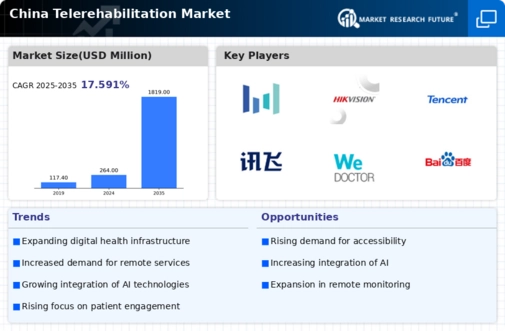Focus on Cost-Effectiveness
Cost considerations are becoming increasingly important in the healthcare landscape of China, influencing the growth of the telerehabilitation market. Telerehabilitation services often present a more cost-effective alternative to traditional rehabilitation methods, reducing travel expenses and time for both patients and providers. As healthcare costs continue to rise, the demand for affordable rehabilitation solutions is expected to increase. Studies suggest that telerehabilitation can reduce overall treatment costs by up to 40%, making it an attractive option for both patients and healthcare systems. This focus on cost-effectiveness is likely to drive the expansion of the telerehabilitation market, as stakeholders seek to optimize resource allocation while maintaining high-quality care.
Government Initiatives and Funding
The Chinese government is increasingly recognizing the importance of rehabilitation services, leading to various initiatives and funding opportunities aimed at enhancing the telerehabilitation market. Policies promoting digital health solutions and telemedicine are being implemented to improve healthcare access, particularly in underserved regions. In recent years, the government has allocated substantial budgets to support the development of telehealth infrastructure, which includes telerehabilitation services. This financial backing is expected to bolster the market, as it encourages healthcare providers to adopt telerehabilitation solutions. With government support, the telerehabilitation market is likely to witness accelerated growth and improved service delivery across the country.
Integration of Advanced Technologies
The telerehabilitation market in China is experiencing a transformation due to the integration of advanced technologies such as artificial intelligence (AI) and virtual reality (VR). These technologies enhance the effectiveness of rehabilitation programs by providing personalized treatment plans and immersive experiences for patients. For instance, AI algorithms can analyze patient data to tailor exercises that suit individual needs, while VR can simulate real-life scenarios for practice. The market is projected to grow at a CAGR of approximately 25% over the next five years, driven by these technological advancements. This integration not only improves patient engagement but also streamlines the delivery of rehabilitation services, making them more accessible and efficient.
Growing Awareness of Telehealth Benefits
There is a notable increase in awareness regarding the benefits of telehealth services among both healthcare providers and patients in China. This growing recognition is significantly impacting the telerehabilitation market, as more individuals are seeking remote rehabilitation options. Patients appreciate the convenience and flexibility that telerehabilitation offers, allowing them to engage in therapy from the comfort of their homes. Surveys indicate that approximately 70% of patients express a preference for telehealth services over traditional in-person visits. This shift in patient attitudes is likely to drive the adoption of telerehabilitation solutions, leading to a more robust market presence and improved patient satisfaction.
Rising Demand for Rehabilitation Services
The increasing prevalence of chronic diseases and disabilities in China is driving the demand for rehabilitation services. As the population ages, the need for effective rehabilitation solutions becomes more pronounced. The telerehabilitation market is poised to benefit from this trend, as it offers convenient access to rehabilitation services for patients who may have mobility issues or live in remote areas. According to recent estimates, the number of individuals requiring rehabilitation services in China is expected to rise by over 30% in the next decade. This surge in demand presents a significant opportunity for the telerehabilitation market to expand its reach and improve patient outcomes through innovative digital solutions.

















Leave a Comment